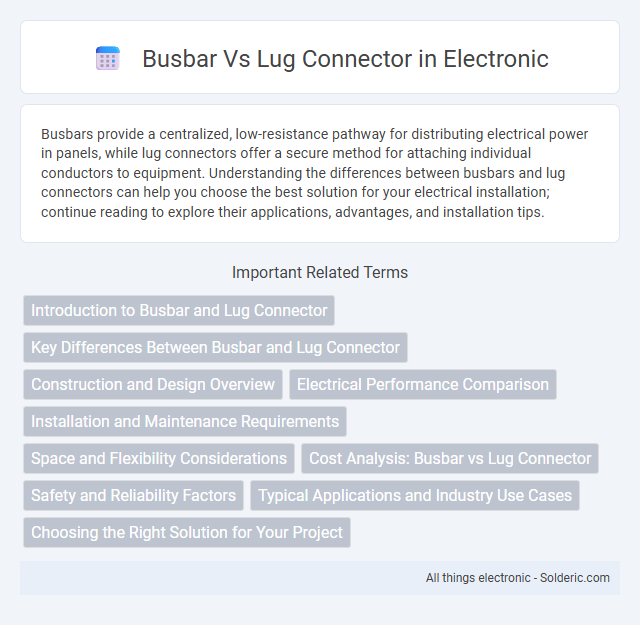Busbars provide a centralized, low-resistance pathway for distributing electrical power in panels, while lug connectors offer a secure method for attaching individual conductors to equipment. Understanding the differences between busbars and lug connectors can help you choose the best solution for your electrical installation; continue reading to explore their applications, advantages, and installation tips.
Comparison Table
| Feature | Busbar | Lug Connector |
|---|---|---|
| Function | Distributes electrical power within switchboards and panels | Connects electrical cables to equipment or busbars securely |
| Material | Typically copper or aluminum for high conductivity | Usually copper or aluminum with insulation options |
| Installation | Fixed mounting inside panels, requires precise cutting and drilling | Bolted or crimped onto cable ends, easier to install |
| Current Capacity | Handles high currents, depending on size and thickness | Varies by lug size; generally supports moderate to high currents |
| Usage | Power distribution in electrical switchgear and bus systems | Cable termination and connection to equipment or busbars |
| Maintenance | Low maintenance, durable under electrical load | Requires regular inspection for tightness and corrosion |
| Cost | Higher initial cost due to material and fabrication | Lower cost, economical for cable connections |
Introduction to Busbar and Lug Connector
Busbars are rigid metallic strips or bars used to conduct electricity within switchboards, panel boards, and busway enclosures, offering efficient power distribution and low resistance connections. Lug connectors, made from copper or aluminum, are designed to securely attach cables to busbars or terminals, providing reliable electrical and mechanical connections. Both components are essential in electrical systems for ensuring safe and effective current flow management.
Key Differences Between Busbar and Lug Connector
Busbars provide a centralized, rigid conductor system designed for high current distribution and easy connection of multiple circuits, while lug connectors serve as individual attachment points securing cables to electrical devices or busbars. Busbars offer a flat or solid metal bar structure that supports efficient heat dissipation and reduced electrical resistance, whereas lug connectors use mechanical compression or crimping to ensure secure wire termination. The primary distinction lies in busbars acting as a main distribution backbone for power systems, contrasting with lugs functioning as connection interfaces between cables and electrical components.
Construction and Design Overview
Busbars are typically flat or rectangular metal strips made from copper or aluminum, designed for high current distribution with minimal resistance and heat buildup. Lug connectors consist of a metal sleeve with a hole for securing cables, often made from copper or aluminum and designed to provide a secure and reliable connection between cables and busbars or equipment. Your choice between a busbar and lug connector depends on the application requirements, including current capacity, mechanical strength, and installation ease.
Electrical Performance Comparison
Busbars offer superior electrical performance compared to lug connectors by providing lower resistance and minimizing voltage drop in high-current applications. Their solid metal construction allows for efficient current distribution and enhanced thermal management, reducing heat buildup during operation. You benefit from improved reliability and durability in power distribution systems when choosing busbars over multiple lug connectors.
Installation and Maintenance Requirements
Busbars offer quick installation with minimal tools and simpler maintenance due to their modular design, allowing easy panel modifications and fault isolation. Lug connectors require precise crimping or soldering, demanding more skilled labor and periodic inspections to prevent loosening or corrosion. Both methods need regular checks, but busbars reduce downtime because of their straightforward accessibility and standardized components.
Space and Flexibility Considerations
Busbars offer superior space efficiency by consolidating multiple connections into a compact, flat conductive strip, ideal for installations with limited room. Lug connectors, while less space-saving due to individual cable terminations, provide greater flexibility in accommodating various wire sizes and configurations. Your choice depends on whether optimizing space or adapting to diverse wiring needs is the priority.
Cost Analysis: Busbar vs Lug Connector
Busbars generally offer a higher upfront cost compared to lug connectors due to their material requirements and manufacturing complexity, but they provide better long-term savings through enhanced durability and reduced maintenance in large-scale electrical systems. Lug connectors are typically more cost-effective for smaller or less complex installations, with lower installation costs and quicker setup times. Your choice should consider both initial expenses and operational efficiency to optimize overall cost-effectiveness.
Safety and Reliability Factors
Busbars offer superior safety due to their solid, compact design that minimizes arcing and heat buildup, reducing the risk of electrical faults. Lug connectors provide reliable connections when properly installed, but they require regular inspection to prevent loosening and corrosion that can compromise performance. Your choice between busbar and lug connectors should consider the maintenance demands and potential failure points to ensure long-term safety and reliability.
Typical Applications and Industry Use Cases
Busbars are commonly used in power distribution systems and switchgear assemblies for efficient current carrying and distribution in industrial plants, data centers, and electrical substations. Lug connectors are preferred in residential, commercial, and light industrial wiring applications due to their ease of installation for securing cables to terminals or busbars. Both components are essential in electrical panel construction, but busbars excel in high-current, centralized grounding, while lugs are suited for flexible, secure cable termination.
Choosing the Right Solution for Your Project
Selecting between a busbar and a lug connector depends on your project's current capacity and space constraints; busbars offer efficient, high-capacity power distribution in compact layouts, while lug connectors provide flexibility for individual cable connections in varied configurations. Consider the electrical load, installation environment, and maintenance requirements to determine the best fit. Ensuring compatibility with your system's voltage and safety standards enhances performance and longevity.
Busbar vs Lug connector Infographic

 solderic.com
solderic.com